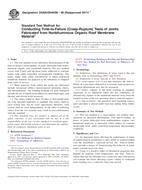Potrebujeme váš súhlas na využitie jednotlivých dát, aby sa vám okrem iného mohli ukazovať informácie týkajúce sa vašich záujmov. Súhlas udelíte kliknutím na tlačidlo „OK“.
ASTM D5405/D5405M-98(2011)e1
Standard Test Method for Conducting Time-to-Failure (Creep-Rupture) Tests of Joints Fabricated from Nonbituminous Organic Roof Membrane Material (Includes all amendments And changes 11/25/2015).
Automaticky preložený názov:
Štandardná skúšobná metóda pre dirigovanie time-to-zlyhanie (Creep pretrhnutie) skúšky spojov, vyrobené z Nonbituminous ekologického hydroizolácie Materiál
NORMA vydaná dňa 1.5.2011
Informácie o norme:
Označenie normy: ASTM D5405/D5405M-98(2011)e1
Poznámka: NEPLATNÁ
Dátum vydania normy: 1.5.2011
Kód tovaru: NS-31052
Počet strán: 5
Približná hmotnosť: 15 g (0.03 libier)
Krajina: Americká technická norma
Kategória: Technické normy ASTM
Anotácia textu normy ASTM D5405/D5405M-98(2011)e1 :
Keywords:
creep, creep-rupture, joints, lap-shear, membranes, roofing, seams, test method, T-peel, Creep, Creep rupture, Joints (roofing), Lap-shear applications/testing, Membranes, Nonbituminous organic roof membranes, Plastic sheet and film, Rheology/rheological properties, Roofing membranes, Seams, Shear testing--roofing materials, Thermoplastic roofing/waterproofing materials, Time-to-failure (TTF), T-peel test, Vulcanized rubbers, ICS Number Code 91.100.50 (Binders. Sealing materials)
Doplňujúce informácie
| Significance and Use | ||||||||
|
An important factor affecting the performance of joints of nonbituminous membranes is their ability to remain bonded over the membrane's expected service life. Time-to-failure tests provide a means of characterizing the behavior of joints under constant load over time. Creep is a sensitive index of rheological properties that depend on material, load, temperature, and time. Time-to-failure data that are obtained over a relatively short time period can evaluate one factor affecting a joint's ability to withstand static loading over a relatively long time period. Time-to-failure data for joints of nonbituminous organic roof membrane specimens can be used for the following: (1) to provide a measure of the load-carrying ability of the joint as a function of time at various levels of load, temperature, and relative humidity; (2) to characterize the joint with regard to factors affecting performance, such as surface preparation of the adherend, solvent-based adhesive thickness and open time, environment during adhesive application and cure, and temperature of thermal welding processes; and (3) to compare the effects of different bonding processes or adhesive bonding materials on joint performance. While it is considered that the results obtained by this laboratory test may afford a measure of the performance of seams in service, provided that load, temperature, and humidity conditions are known, no direct correlation has been established. |
||||||||
| 1. Scope | ||||||||
|
1.1 This test method covers laboratory determination of the time-to-failure (creep-rupture) of joints fabricated from nonbituminous organic roof membrane material. The test method covers both T-peel and lap-shear joints subjected to constant tensile load under controlled environmental conditions. The joints, made from either unreinforced or fabric-reinforced membrane material, are prepared in the laboratory or sampled from roofs in service. 1.2 Sheet materials from which the joints are fabricated include vulcanized rubbers, nonvulcanized polymeric sheets, and thermoplastics. The bonding methods for joint formation include the use of liquid-based adhesives, preformed tapes, and thermal and solvent weld processes. 1.3 The values stated in either SI units or inch-pound units are to be regarded separately as standard. The values stated in each system may not be exact equivalents; therefore, each system shall be used independently of the other. Combining values from the two systems may result in non-conformance with the standard. 1.4 This standard does not purport to address all of the safety concerns, if any, associated with its use. It is the responsibility of the user of this standard to establish appropriate safety and health practices and determine the applicability of regulatory limitations prior to use. |
||||||||
| 2. Referenced Documents | ||||||||
|




 Cookies
Cookies
